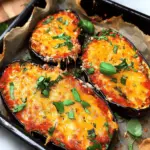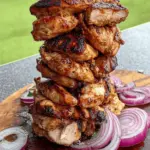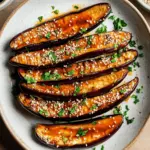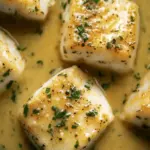This Mango Panna Cotta is a vegan and dairy-free twist on the classic Italian dessert, made without gelatin or cornstarch. Using tropical mango, coconut cream, and a touch of lime, it delivers a creamy, refreshing texture with a gentle wobble—thanks to plant-based agar-agar. Light, fruity, and elegant, it’s a perfect summer dessert or dinner party finale.
Full Recipe:
Ingredients
-
200g (¾ cup + 2 tbsp) mango pulp (canned or fresh purée)
-
200ml (¾ cup + 2 tbsp) almond milk or soy milk
-
50g (¼ cup) granulated sugar
-
½ tsp agar-agar powder (not flakes)
-
240g (1 cup) coconut cream or the solid part from chilled full-fat canned coconut milk
-
¼ tsp sea salt
-
1 tsp lime zest (optional)
Directions
-
Combine Ingredients: In a saucepan, whisk together the mango pulp, plant milk, sugar, and agar powder.
-
Simmer: Bring to a simmer over medium heat and cook for 5 minutes, whisking regularly until the mixture thickens slightly and coats a spoon.
-
Add Coconut & Flavor: Lower the heat and stir in coconut cream, salt, and lime zest. Heat for another minute until melted—do not boil.
-
Strain: Pour through a fine sieve into a bowl or jug to ensure a smooth finish.
-
Pour Into Molds: Divide mixture into flexible molds (or small cups). Let cool for 10 minutes, then cover and refrigerate for at least 4 hours or overnight.
-
Serve: Unmold by gently pressing the sides of the silicone mold. Optionally garnish with extra lime zest or fresh mango chunks.
Nutrients (approximate per serving, based on 4 servings)
-
Calories: ~280 kcal
-
Fat: ~20g
-
Carbohydrates: ~20g
-
Sugar: ~18g
-
Protein: ~2g
-
Fiber: ~1g
-
Sodium: ~80mg
A Vegan Take on an Italian Classic
Panna cotta, which translates to “cooked cream” in Italian, is traditionally made by simmering cream, milk, and sugar with gelatin before chilling to a delicate set. This vegan version respects the spirit of the dish while using entirely plant-based ingredients. Coconut cream replaces the dairy, offering a rich, smooth mouthfeel, while almond or soy milk adds lightness and helps balance the intensity of the coconut flavor.
The use of agar-agar powder, rather than gelatin, ensures the dessert remains completely vegan. Agar sets differently from gelatin—it produces a firmer, slightly more brittle set if overused—so precision is key. In this recipe, just half a teaspoon is enough to provide a perfect panna cotta consistency: a soft, creamy texture that yields gently to the spoon, yet holds its shape on the plate.
The Tropical Sweetness of Mango
Mango is the star of this dish, providing not just sweetness and color but also a luxurious, smooth body to the base. Using either fresh mango purée or high-quality canned mango pulp, the dessert is infused with the fruit’s sunny, vibrant essence. Mango complements coconut beautifully, both in flavor and texture, making it a natural fit for this tropical interpretation of panna cotta.
The fruit’s natural sugars allow for a reduced amount of added sweetener, keeping the dish light and balanced. When using canned mango pulp, which is often sweeter and more consistent in texture, you may want to reduce the sugar slightly depending on your preference. Fresh mango purée provides a brighter, more nuanced flavor but may require straining for the smoothest finish.
Coconut Cream for Richness Without Dairy
Coconut cream adds richness and silkiness to the panna cotta, mimicking the role of heavy cream in traditional recipes. Its natural fat content gives the dessert a luscious texture and a subtle coconut aroma that complements the mango rather than overpowering it. When chilled and set, the combination of mango and coconut becomes delightfully creamy and spoonable—an ideal showcase of plant-based indulgence.
For best results, use only the solid portion from a can of full-fat coconut milk that has been refrigerated overnight, or purchase canned coconut cream. Avoid using coconut milk beverages or low-fat varieties, which lack the body needed to give the dessert its luxurious feel.
The Role of Agar-Agar and How to Use It
Agar-agar is a plant-based gelling agent derived from red algae. Unlike gelatin, it sets at room temperature and holds its shape more firmly, making it excellent for molded desserts. However, it must be simmered properly to dissolve completely—simply stirring it into warm liquid isn’t enough.
In this recipe, the agar is cooked into the mango and plant milk mixture first to ensure it dissolves thoroughly before the coconut cream is added. This step is important, as bringing the full-fat coconut cream to a boil can result in separation or an oily texture. The key to a smooth panna cotta lies in gently heating the mixture, straining it, and allowing it to cool slightly before refrigerating.
The finished dessert sets within a few hours and unmolds cleanly from flexible silicone molds or ramekins. For extra elegance, serve it inverted on a small plate and garnish with lime zest or mango cubes.
Lime Zest: A Subtle Finishing Touch
Though optional, lime zest adds brightness and a subtle tang that offsets the sweetness of the mango and coconut. It cuts through the richness and enhances the tropical feel of the dessert, providing a light citrus note in both aroma and taste. A little goes a long way—just a sprinkle over the top adds visual contrast and complexity to each bite.
You can also experiment with a drizzle of lime syrup or a tiny pinch of sea salt on top for a bold, modern twist. Fresh mint or toasted coconut flakes are other garnish options that enhance both texture and presentation.
A Make-Ahead Dessert for Effortless Entertaining
Mango Panna Cotta is an ideal make-ahead dessert. Once poured into molds, it requires no further effort beyond chilling, which means you can prepare it the day before and simply unmold and serve when needed. This makes it perfect for hosting, especially when you want a stress-free but elegant finish to a meal.
Its eye-catching appearance and vibrant color make it stand out on any dessert table, while its light and refreshing flavor ensure it’s a hit even after a hearty main course. Serve it directly in glasses for a casual presentation, or unmold onto dessert plates for a formal setting.
Customizable and Diet-Friendly
Beyond being vegan and dairy-free, this panna cotta is also adaptable to other dietary needs. It’s naturally gluten-free, and the sugar content can be adjusted to taste or substituted with agave syrup or coconut sugar for a more natural sweetener option.
You can also change the flavor profile entirely by swapping the mango for other fruit purées such as passionfruit, strawberry, raspberry, or peach. Keep in mind that acidic fruits may require a slight increase in agar to set properly. For a layered effect, let one flavor set partially before adding the next layer.
Even the milk base can be changed—oat milk, rice milk, or cashew milk work just as well as almond or soy. Each brings its own flavor and creaminess, allowing you to customize the dessert to suit your preferences or the season.
Nutritional Balance and Light Indulgence
This dessert is light in both feel and nutritional profile. At around 280 calories per serving, it’s satisfying without being overindulgent. It contains roughly 20 grams of fat, primarily from the coconut cream, and about 20 grams of carbohydrates from the fruit and sweetener. The fiber and vitamins from the mango make it a slightly more nutrient-rich dessert option, while the absence of dairy and refined thickeners makes it suitable for those with common allergies or dietary restrictions.
Despite being creamy and luxurious, it won’t weigh you down. This makes it an ideal treat for warm-weather dining, especially when served chilled straight from the fridge.
Conclusion
Mango Panna Cotta is a testament to how simple, plant-based ingredients can create a dessert that’s elegant, flavorful, and indulgent—all without dairy, gelatin, or cornstarch. With its vibrant mango flavor, creamy coconut base, and delicate wobble from agar-agar, this dish proves that vegan desserts can be every bit as luxurious and satisfying as their traditional counterparts.
Whether you’re preparing a dinner party finale, a cooling summer treat, or a thoughtful offering for guests with dietary needs, this recipe ticks all the boxes. It’s easy to make, stunning to serve, and endlessly adaptable. With Mango Panna Cotta, you get the best of both worlds—pure tropical indulgence and wholesome plant-based simplicity in every silky spoonful.






